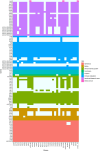Acinetobacter pittii: the emergence of a hospital-acquired pathogen analyzed from the genomic perspective
- PMID: 38989032
- PMCID: PMC11233732
- DOI: 10.3389/fmicb.2024.1412775
Acinetobacter pittii: the emergence of a hospital-acquired pathogen analyzed from the genomic perspective
Abstract
Acinetobacter pittii has increasingly been associated with several types of hospital-acquired severe infections. Genes implicated in carbapenem resistance, tigecycline resistance, or genes encoding extended spectrum cephalosporinases, such as blaADC, are commonly found in isolates implicated in these infections. A. pittii strains that are pandrug resistant have occasionally been identified. Food for human consumption, animals and plants are environmental sources of this pathogen. An alarming situation is that A. pitti has been identified as responsible for outbreaks in different regions worldwide. In this study, 384 genomes of A. pittii were analyzed, comprising sequences from clinical and non-clinical origins from 32 countries. The objective was to investigate if clinical strains possess genetic traits facilitating hospital adaptation. Results indicate significant genomic variability in terms of size and gene content among A. pittii isolates. The core genome represents a small portion (25-36%) of each isolate's genome, while genes associated with antibiotic resistance and virulence predominantly belong to the accessory genome. Notably, antibiotic resistance genes are encoded by a diverse array of plasmids. As the core genome between environmental and hospital isolates is the same, we can assume that hospital isolates acquired ARGs due to a high selective pressure in these settings. The strain's phylogeographic distribution indicates that there is no geographical bias in the isolate distribution; isolates from different geographic regions are dispersed throughout a core genome phylogenetic tree. A single clade may include isolates from extremely distant geographical areas. Furthermore, strains isolated from the environment or animal, or plant sources frequently share the same clade as hospital isolates. Our analysis showed that the clinical isolates do not already possess specific genes, other than antibiotic-resistant genes, to thrive in the hospital setting.
Keywords: ESKAPE; antibiotic-resistance genes; evolution; infection; virulence.
Copyright © 2024 Bello-López, Escobedo-Muñoz, Guerrero, Cruz-Córdova, Garza-González, Hernández-Castro, Zarain, Morfín-Otero, Volkow, Xicohtencatl-Cortes and Cevallos.
Conflict of interest statement
The authors declare that the research was conducted in the absence of any commercial or financial relationships that could be construed as a potential conflict of interest. The author(s) declared that they were an editorial board member of Frontiers, at the time of submission. This had no impact on the peer review process and the final decision.
Figures




References
LinkOut - more resources
Full Text Sources
Molecular Biology Databases
Research Materials

